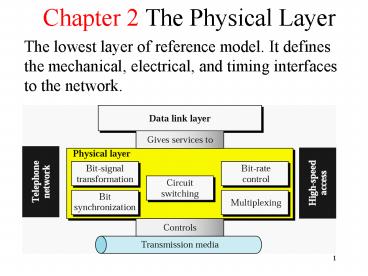Chapter 2 The Physical Layer PowerPoint PPT Presentation
1 / 26
Title: Chapter 2 The Physical Layer
1
- Chapter 2 The Physical Layer
The lowest layer of reference model. It defines
the mechanical, electrical, and timing interfaces
to the network.
2
Bandwidth-Limited Signals
- A binary signal and its root-mean-square Fourier
amplitudes. - (b) (c) Successive approximations to the
original signal.
3
Bandwidth-Limited Signals (2)
- (d) (e) Successive approximations to the
original signal.
4
BANDWIDTH AND INFORMATION CAPACITY
Bandwidth is the span of frequencies within the
spectrum occupied by a signal and used by the
signal for conveying information. Carrying
information requires bandwidth.
5
Noiseless Channel Nyquist Bit Rate
L is the number of signal levels used to
represent data.
Increasing the levels of a signal may reduce the
reliability of the system.
6
Noisy Channel Shannon Capacity
The theoretical highest data rate for a noisy
channel
where capacity is in bits/second, bandwidth is in
hertz, and signal and noise powers are measured
in the same physical units, such as watts. Bits
are fundamental units of information.
7
Using both limits
- The Shannon capacity gives us the upper limit
- the Nyquist formula tells us how many signal
levels we need.
8
Guided Transmission Data
- Magnetic Media
- Twisted Pair
- Coaxial Cable
- Fiber Optics
WirelessTransmission
- The Electromagnetic Spectrum
- Radio Transmission
- Microwave Transmission
- Infrared and Millimeter Waves
- Lightwave Transmission
9
The Electromagnetic Spectrum
- The electromagnetic spectrum and its uses for
communication.
10
Structure of the Telephone System
Public Switched Telephone System
- (a) Fully-interconnected network.
- (b) Centralized switch.
- (c) Two-level hierarchy.
11
Signal Encoding Techniques
- Digital data, digital signal
- Analog data, digital signal
- Digital data, analog signal
- Analog data, analog signal
12
Encoding Schemes
13
NRZ
14
Biphase
- Manchester
- Transition in middle of each bit period
- Transition serves as clock and data
- Low to high represents one
- High to low represents zero
- Used by IEEE 802.3
- Differential Manchester
- Mid-bit transition is clocking only
- Transition at start of a bit period represents
zero - No transition at start of a bit period represents
one - Note this is a differential encoding scheme
- Used by IEEE 802.5
15
Manchester Encoding
16
- TQ 6. The waveform of following figure belongs to
a Manchester encoded binary data stream.
Determine the beginning and end of bit periods
(i.e., extract clock information) and give the
data sequence.
17
Modulation Rate
18
Digital Data, Analog Signal
- Public telephone system
- 300Hz to 3400Hz
- Use modem (modulator-demodulator)
- Amplitude shift keying (ASK)
- Frequency shift keying (FSK)
- Phase shift keying (PK)
19
Modulation Techniques
20
Modems (2)
Constellation Diagrams
- (a) QPSK.
- (b) QAM-16.
- (c) QAM-64.
21
Modems (3)
(b)
(a)
- (a) V.32 for 9600 bps.
- (b) V32 bis for 14,400 bps.
22
Multiplexing
Frequency Division MultiplexingWavelength
Division MultiplexingTime Division Multiplexing
23
Simple Circuit Switched Network
24
Packet Switching
25
Basic Operation
- Data transmitted in small packets
- Typically 1000 octets (bytes)
- Longer messages split into series of packets
- Each packet contains a portion of user data plus
some control information - Control information
- Routing (addressing) information
- Packets are received, stored briefly (buffered)
and past on to the next node - Store and forward
26
Advantages
- Line efficiency
- Single node to node link can be shared by many
packets over time - Packets queued and transmitted as fast as
possible - Data rate conversion
- Each station connects to the local node at its
own speed - Nodes buffer data if required to equalize rates
- Packets are accepted even when network is busy
- Delivery may slow down
- Priorities can be used

